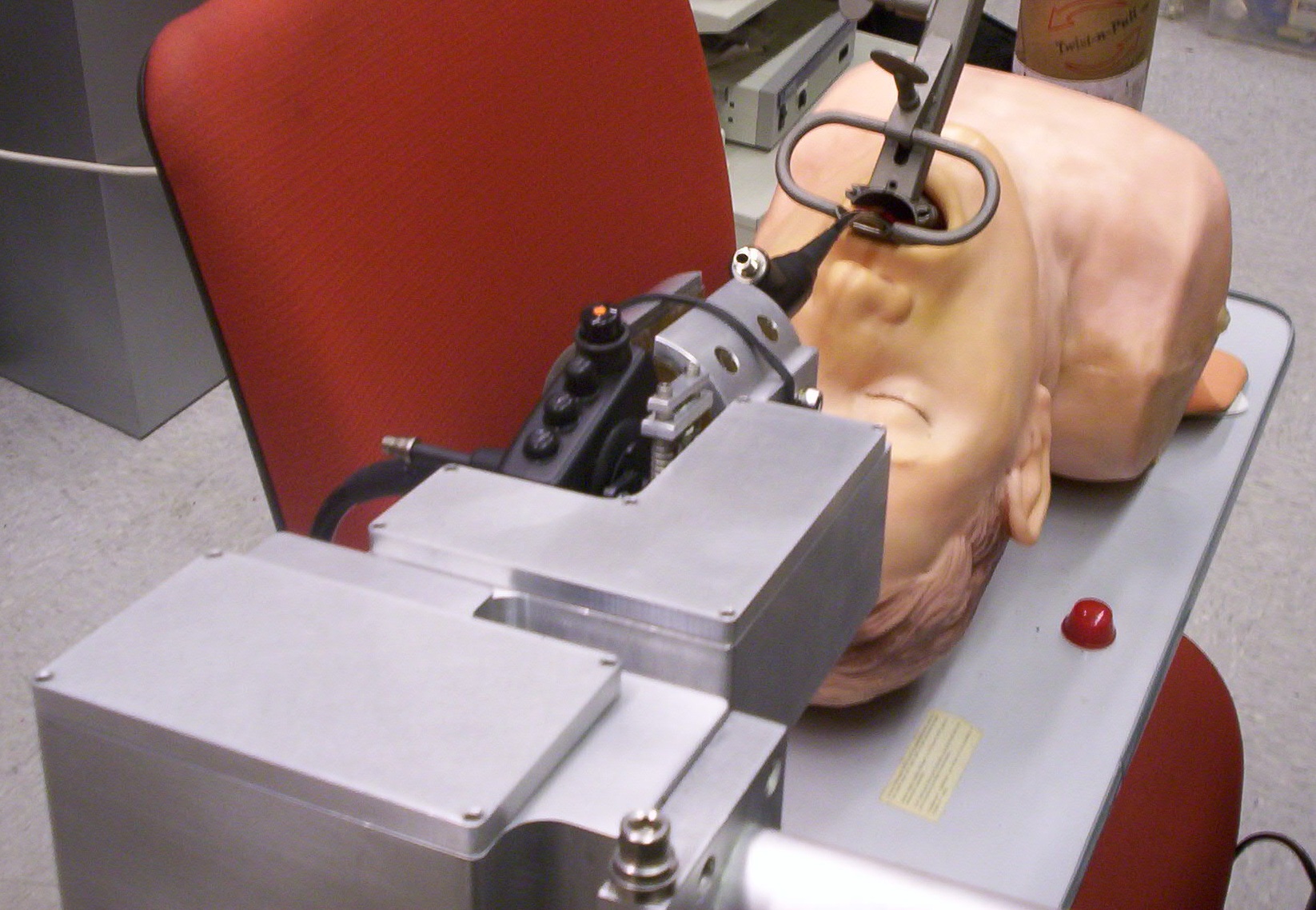Table of Contents
Robotic Laryngeal Surgery
 Over 25,000 new cases of throat cancer are reported every year in the US, resulting in approximately 6,000 deaths per year 1). Since the throat area is fraught with complications for many cancer treatment techniques, such as radiation and chemotherapy, but relatively accessible to surgical techniques, a surgical approach is often taken. Two main surgical techniques are used: conventional surgery, and intra-airway surgery. Intra-airway surgery has many advantages over conventional surgery, including faster healing, less chance of infection, less visible scarring, and less risk of complications, but due to the confined space and poor visibility in the airway, such surgeries are often difficult and time consuming to perform. These difficulties can be partially overcome by using a flexible laryngoscope with a working port, but the problem of adequately controlling the scope with millimeter accuracy for sometimes hours at a time remains. This project seeks to solve this problem by using a robot to control the laryngoscope, thus allowing the surgeon to bypass the details of actuating the scope and focus on the higher level goals of the operation.
Over 25,000 new cases of throat cancer are reported every year in the US, resulting in approximately 6,000 deaths per year 1). Since the throat area is fraught with complications for many cancer treatment techniques, such as radiation and chemotherapy, but relatively accessible to surgical techniques, a surgical approach is often taken. Two main surgical techniques are used: conventional surgery, and intra-airway surgery. Intra-airway surgery has many advantages over conventional surgery, including faster healing, less chance of infection, less visible scarring, and less risk of complications, but due to the confined space and poor visibility in the airway, such surgeries are often difficult and time consuming to perform. These difficulties can be partially overcome by using a flexible laryngoscope with a working port, but the problem of adequately controlling the scope with millimeter accuracy for sometimes hours at a time remains. This project seeks to solve this problem by using a robot to control the laryngoscope, thus allowing the surgeon to bypass the details of actuating the scope and focus on the higher level goals of the operation.
Project Goals
The main goal of this project is to create a robotic scope manipulation system for laryngeal surgery. The be clinically useful, such a system would need to:
- have equal or superior precision to manual scope manipulation
- pass all clinical regulatory requirements
- be rugged enough to withstand typical operating room conditions
- hold the scope steady even when the surgeon releases the system to attend to other tasks
- be easy and simple for users with little or no technical background to set up and use
- introduce no unnecessary risks into the procedure
Approach
Our approach includes a custom built robot to manipulate the endoscope and a software system to allow the surgeon to easily manipulate the scope using only one hand.
Status and Results to Date
 We created an initial proof of concept prototype using the LARS robot over the summer of 2009. Once this prototype was tested and approved, we began work on a ruggedized clinical prototype in fall of 2009. The first iteration of the ruggedized prototype was completed in spring 2010. After further testing and evaluation, we began the second iteration of the ruggedized prototype, which includes several enhancements and modifications. We plan to finish the second iteration by the end of winter 2011.
We created an initial proof of concept prototype using the LARS robot over the summer of 2009. Once this prototype was tested and approved, we began work on a ruggedized clinical prototype in fall of 2009. The first iteration of the ruggedized prototype was completed in spring 2010. After further testing and evaluation, we began the second iteration of the ruggedized prototype, which includes several enhancements and modifications. We plan to finish the second iteration by the end of winter 2011.
Future Plans
Once the second iteration of the ruggedized prototype is complete, we conduct an evaluative study using a rubber phantom with an anatomically realistic larynx. Once the system can effectively perform mock surgeries using the phantom, we will move forward to cadaver testing. Once cadaver testing is complete, we plan to apply for IRB approval for human clinical trials.
Project Personnel
Students:
- Kevin Olds
- Elizabeth Cha
Advisors:
- Jeremy Richmon MD
- Russel Taylor
Funding
- Project is supported by the JHMI Department of Otolaryngology
Affiliated labs
Publications
- In progress